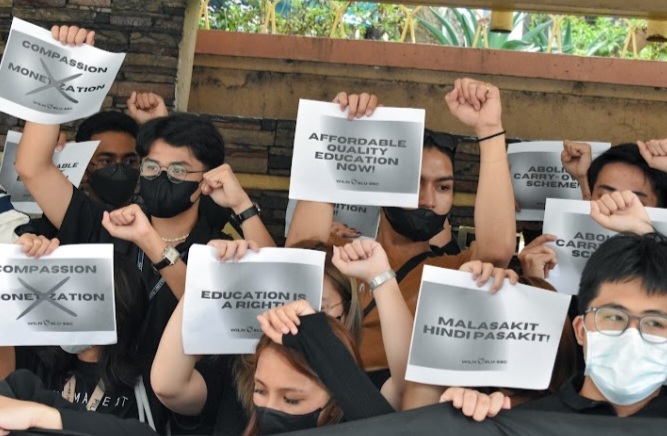
Students of Saint Louis University in Baguio City stage a protest rally outside their campus in this photo taken on April 24 to oppose the impending increase in tuition and other school fees. (Photo by Jethro Bryan Andrada)
BAGUIO CITY—Students from Saint Louis University (SLU) and the University of the Cordilleras (UC) continue to oppose the looming tuition and other fees increase (TOFI) in their respective universities, claiming it is “unjust” given the economic conditions of the region and the country.
The impending tuition hikes, set at 9 percent for SLU and 10 percent for UC, are the highest in five years for both schools and will be implemented among the incoming freshmen.
Private universities across the country are also planning similar steps. Last month, Manila students called on the Commission on Higher Education (CHEd) to intervene, citing intense inflation as grounds for a tuition moratorium.
On Sunday, students from the two Baguio universities appealed to their respective school administrations to implement a moratorium on tuition increases or at least provide transparency. Both SLU and UC have yet to respond to the students’ call for a moratorium and explanation.
“It is very frustrating, especially considering the grave economic situation with the 7.7-percent regional inflation,” said Ren De Jesus, a third-year behavioral science student from UC, in an interview with the Inquirer.
De Jesus and other students at UC and SLU have been asking their university administrations how the funds from the impending fee hike will be spent.
According to CHEd Memorandum 3, series of 2012, student councils and faculty must be consulted before implementing TOFI.
No consultations?
When asked if their student council was informed about the TOFI at UC, De Jesus said they were not consulted.
“The TOFI announcement was released during our term break when people were not in school,” De Jesus said.
Mario Oriana, an incoming freshman at UC, described the TOFI as “unfair,” stating that the school administration did not involve students in the decision-making process.
“We really don’t know why it’s 10 percent or where the money from that increase is going to go. There’s no explanation or justification. It just existed,” Oriana said in a separate interview.
Gabrielle Francisco, the Supreme Student Council President at SLU, stated that the consultations for TOFI were delayed.
“The consultations were supposed to be done in the first semester. Technically speaking, what else do the students need to do? Imagine, three days before the deadline of CHEd, they only showed the proposed changes,” Francisco said.
Kevin Pineda, a third-year political science student at SLU, noted that the university’s explanation regarding TOFI was vague.
Recoup losses
In a previous dialogue with students in April, the SLU administration stated that the increase would help recoup profit losses from the past two years without TOFI.
But Pineda mentioned that SLU was charging fees for internet, visual and information technology, among others, despite these services not being used due to the campus being vacated.
According to the Inquirer, the additional funds generated from TOFI are spent by SLU based on CHEd Memorandum 3, series of 2012.
Seventy percent of the TOFI budget is allocated for faculty and staff wages and benefits, while the remaining 20 percent goes toward improving facilities, laboratories, and equipment.
However, Pineda lamented that in both SLU and UC, some facilities and equipment remained “dysfunctional.”
“Many classes use the laboratories and reagents, and they distribute the lacking laboratory equipment, making it harder to perform the lab activities. Inside the classrooms, there are many run-down chairs that are uncomfortable to use,” Pineda explained.
Francisco also stated that this problem is widespread across many colleges in SLU.
Other fees
De Jesus said it also remained unclear to UC students where all the additional funds from TOFI are channeled since the students also pay a fee for the maintenance and development of UC’s land and facilities.
“Aside from the increase in tuition, we also pay P500 LIMAD fee (land, infrastructure, maintenance, acquisition, and development), which will now be P550,” De Jesus said.
De Jesus added: “The students have been questioning for a long time because even the breakdown is not included in our white form.”
Despite the increase in tuition and the LIMAD fee in recent years, De Jesus stated that UC students have not experienced any improvement in student services.
“[It is intriguing that the students have to pay excessively, but they do not even fix the portal. There are always errors. Other projectors also don’t work properly. We have to move to other classrooms so we can present and use the projector properly,” De Jesus said.
While the country reels from inflation and the rising prices of goods, “it would be best if we had a halt with the tuition increase.,” according to De Jesus.
“But if that’s not possible, I hope the school administration is transparent,” Oriana said.
On April 24th, SLU students staged a rally at the main gate of their Bonifacio campus to protest the impending TOFI that the school administration plans to impose for the academic year 2023-2024.
“We want to have more discussions with [the school administration], too, to get an answer to why there’s a tuition fee increase in the first place,” Oriana said.
The Inquirer tried to reach officials of the two schools on Tuesday, but they were not immediately available for comment. INQ
READ:
SLU students in Baguio City protest looming tuition hike
Baguio students rally to denounce Red-tagging, tuition hikes